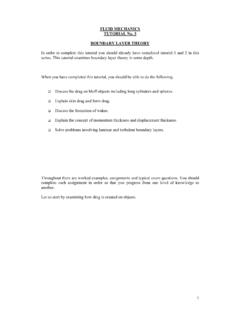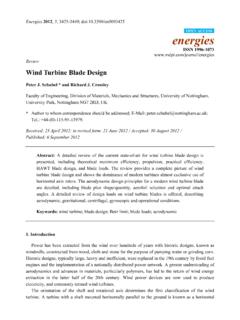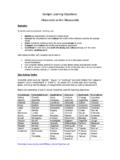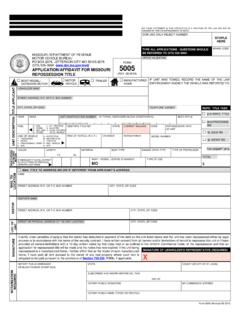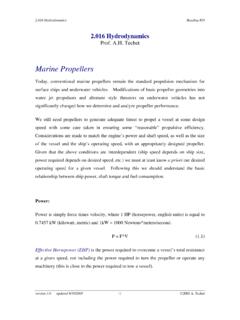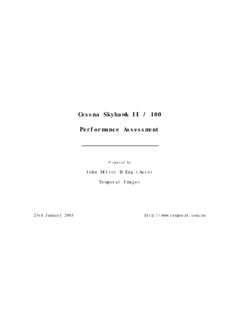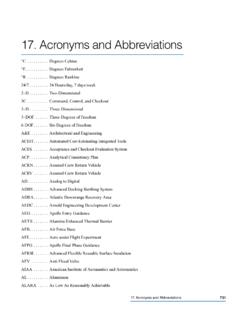Transcription of Axes / Control Surfaces - NASA
1 National Aeronautics and Space aBOXM useumin aBOXS eriesAeronautics ResearchMission Directorate5-8 GRADES principles of flightAxes / Control Surfaces2principles of flightMUSEUM IN A BOX axes / Control SurfacesLesson OverviewThrough hands-on experiments and physical demonstrations, students will learn about motions and forces, transfer of energy, and the abilities of technological design as they study some of the basic concepts of flight, including the three axes of flight and the Control Surfaces that guide the aircraft. Objectives Students how to identify the various parts of the airplane and gain a basic understanding of their an understanding of the three axes of :In the BoxNoneProvided by UserPencils (3 per student)TapeScissorsGRADESTime Requirements: 1 hour 20 minutes5-83principles of flightMUSEUM IN A BOXB ackgroundThe mechanics of flight are highly complex, encompassing principles such as the four forces and axes , as well as technical terms such as Control Surfaces , adverse yaw and coordinated flight.
2 While this lesson covers all of these topics, its purpose is to provide just a very basic insight into the true mechanics of flight and body-axis systems. Wind-axis systems, which refer to aircraft forces in relation to the direction of the aircraft s velocity, are not discussed here to avoid confusion. Also, some of the explanations given are highly simplified in order to allow educators to help students visualize the principle being discussed. For educators with an aviation background and capable students, modification of these activities and background information is encouraged. The Forces of FlightEvery aircraft, whether an airplane, helicopter or rocket, is affected by four opposing forces: Thrust, Lift, drag and Weight (Fig. 1). Control Surfaces , such as the rudder or ailerons, adjust the direction of these forces, allowing the pilot to use them in the most advantageous way force can be thought of as a push or pull in a specific direction.
3 It is a vector quantity, which means a force has both a magnitude (amount) and a this lesson we will deal specifically with fixed-wing airplanes. Other aircraft, such as hot-air balloons and helicopters, use the same basic principles but the physics are very different. Fig. 1 Four forces of flightLiftWeightThrustDragThrustThrust is produced by an aircraft s propulsion system or engine. The direction of the thrust dictates the direction in which the aircraft will move. For example, the engines on an airliner point backwards, which means that generally speaking, the airplane s thrust vector will point forwards. 4principles of flightMUSEUM IN A BOXLiftLift is generated by the motion of air passing over the aircraft s wings. The direction of lift is always perpendicular to the flight direction (Fig. 2) and its magnitude depends on several factors, including the shape, size and velocity of the aircraft.
4 DragDrag is simply resistance of the aircraft against the air. There are many types of drag , but each is a force opposing thrust. WeightWeight is a force that is always directed toward the center of the earth due to gravity. The magnitude of the weight is the sum of all the airplane parts, plus the fuel, people and cargo. While the weight is distributed throughout the entire airplane, its effect is on a single point called the center of gravity. Fig. 2 The lift and weight forces of flightLiftWeight5principles of flightMUSEUM IN A BOX Controlling the Motion of FlightIn order for an aircraft to reach its destination, the forces of flight have to be precisely manipulated. To do this, the aircraft has Control Surfaces (Fig. 3) which can direct airflow in very specific ways. AileronAileronRudderElevatorFig.
5 3 Aircraft Control surfacesElevator | PitchAs the name implies, the elevator helps elevate the aircraft. It is usually located on the tail of the aircraft and serves two purposes. The first is to provide stability by producing a downward force on the tail. Airplanes are traditionally nose-heavy and this downward force is required to compensate for that. The second is to direct the nose of the aircraft either upwards or downwards, known as pitch, in order to make the airplane climb and descend. (Fig. 4).ElevatorFig. 4 Elevator and pitch movementAilerons | RollThe ailerons are located at the rear of the wing, one on each side. They work opposite to each other, so when one is raised, the other is lowered. Their job is to increase the lift on one wing, while reducing the lift on the other. By doing this, they roll the aircraft sideways, which allows the aircraft to turn.
6 This is the primary method of steering a fixed-wing aircraft (Fig. 5).AileronFig. 5 Ailerons and roll movement6principles of flightMUSEUM IN A BOXR udder | YawThe rudder is located on the tail of the aircraft. It works identically to a rudder on a boat, steering the nose of the aircraft left and right. Unlike the boat however, it is not the primary method of steering. Its main purpose is to counteract the drag caused by the lowered aileron during a turn. This adverse yaw, as it is known, causes the nose of the airplane to point away, or outwards, from the direction of the turn. The rudder helps to correct this by pushing the nose in the correct direction, maintaining what is known as coordinated flight (Fig. 6). Fig. 6 Rudder and yaw movement RudderThe axes of Flight Each axis of flight is an imaginary line around which an airplane can turn.
7 Think of an airplane rotating around an axis like a wheel rotates around an axle. Regardless of the type of aircraft, there are three axes upon which it can move: Left and Right, Forwards and Backwards, Up and Down. In aviation though, their technical names are the lateral axis, longitudinal axis and vertical 7 The lateral axisFig. 8 The longitudinal axisRollThe Lateral Axis (Pitch)The lateral axis runs from wing tip to wing tip. The aircraft pitches around this axis (Fig. 7).The Longitudinal Axis (Roll)The longitudinal axis runs from the nose of the aircraft to the tail. This is the axis around which the aircraft rolls (Fig. 8).The Vertical Axis (Yaw)The vertical axis is slightly different to the others, running vertically through the center of the aircraft. The aircraft yaws around this axis (Fig. 9).
8 Ya wFig. 9 The vertical axis7principles of flightMUSEUM IN A BOXThe Center of GravityThe center of gravity, also known as CG, is the effective point whereby all weight is considered to be. The CG is also the same point where the axes of flight meet (Fig. 10). This point isn t fixed on any aircraft, but moves forwards or backwards along the longitudinal axis, depending on how the aircraft is loaded. It is vital that its center of gravity remain within certain limits however, as an aircraft that is too nose- or tail-heavy will either not fly, or be so difficult to Control that it becomes too dangerous to try. These limits are referred to as its operational envelope. Center of GravityFig. 10 Center of gravityRudderLongitudinal AxisVertical AxisLateral AxisFor additional information on aerodynamics and the principles of flight in general, please refer to the Museum in a Box lessons Four Forces and Bernoulli Principle.
9 8principles of flightMUSEUM IN A BOX Activity 1 Parts of an AirplaneGRADES5-8 Time Requirements: 20 minutesMaterials:In the BoxNoneProvided by UserNoneWorksheetsParts of an Airplane(Worksheet 1)Reference MaterialsNoneKey Terms:AileronDragElevatorForce LiftPitchRollRudderThrustWeightYawObject ive:In this activity, students will learn the abilities of technological design as they identify the various parts of the airplane and gain a basic understanding of their functions. Activity Overview:Students will label the aircraft s Control Surfaces , learning the purpose or function of each component in the process. Activity: 1. Provide each student with a copy of the Parts of an Airplane Using the Background information, discuss each of the Control Surfaces with the students as a group. 3. Ask the students to label each of the Control Surfaces on their Have the students complete the first two columns of the table.
10 The final column will be completed in the next activity. Control SURFACEMOVEMENTAXISPITCHE levatorNose Up/DownLateralROLLA ileronWings Up/DownLongitudinalYAWR udderNose Left/RightVerticalAileronAileronElevator ElevatorRudder9principles of flightMUSEUM IN A BOXP arts of an AirplaneDiscussion Points: 1. Where are the ailerons? The ailerons are on the trailing, or rear, edge of the What is their purpose? The ailerons are used to turn the airplane left and Where is the rudder? The rudder is at the back of the airplane, on the What is its purpose? The rudder is used to keep the nose and tail of the airplane pointing in the same Where is the elevator? The elevator is also on the tail of the airplane, below the What is its purpose? The elevator is used to turn and make the airplane climb and of flightMUSEUM IN A BOXNATIONAL SCIENCE STANDARDS 5-8 SCIENCE AS INQUIRY Abilities necessary to do scientific inquiry Understandings about scientific inquiryPHYSICAL SCIENCE Properties and changes of properties in matterSCIENCE AND TECHNOLOGY Abilities of technological design Understanding about science and technology11principles of flightMUSEUM IN A BOXA ctivity 2 The axes of FlightGRADES 5-8 Time Requirements: 60 minutesMaterials:In the BoxNoneProvided by UserPencils(3 per student)TapeScissorsWorksheetsAirplane Template(Worksheet 2)Reference MaterialsNone Key Terms:Center of Gravity (CG)Lateral axisLongitudinal axisPitchRollVertical axisYawObjective.










